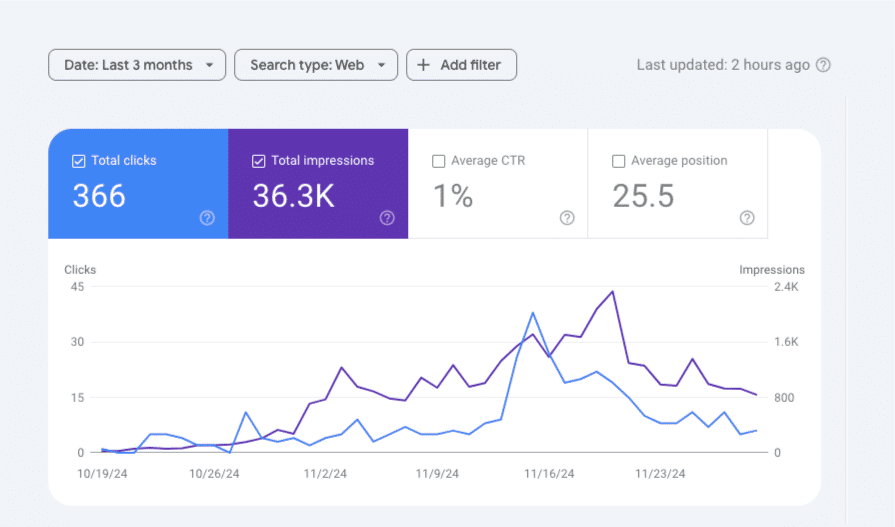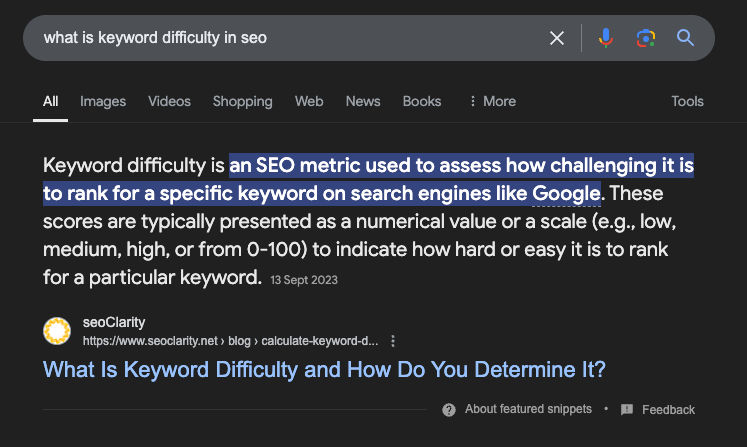
Blog SEO: Everything you need to know
This post aims to help you boost your blog's visibility and attract more readers and ultimately - customers. We'll cover essential SEO techniques, from keyword selection to content optimization, and explore how to leverage AI tools for better results. By the end, you'll have a solid understanding of how to boost your blog SEO, practical strategies to implement, and tips for continuous improvement. Get ready to take your blog to new heights in search engine rankings!
Understanding the Basics of improving Blog SEO
If you're diving into the world of blogging, you've probably heard the term SEO thrown around. SEO is essential to any business blog. But what exactly is it, and why should you care? Let's break it down in simple terms:
- SEO Defined — Search Engine Optimization is the art of making your blog more visible to search engines like Google.
- Keywords Matter — These are the words and phrases people type into search engines. Using them strategically in your content helps search engines understand what your blog is all about.
- Quality Content is King — Both readers and search engines love fresh, relevant, and valuable content. The better your content, the higher you'll rank in search results.
- User Experience Counts — A well-designed, easy-to-navigate blog keeps visitors happy, happy visitors stays longer on your blog — which search engines take into account.
- Backlinks Boost Ranking — When other reputable sites link to your blog, it's like a vote of confidence in search engine eyes.
Understanding these basics is your first step towards making your blog more discoverable. Remember, SEO isn't about tricking search engines – it's about creating a better experience for your readers while making it easier for search engines to understand and showcase your content.
The Importance of SEO for Your Blog's Success
In the huge online world, your blog is like a hidden gem waiting to be found. That's where Search Engine Optimization (SEO) comes in. Here's why SEO is crucial for your blog's success:
- Increased visibility — SEO helps your blog climb the search engine rankings, making it easier for potential readers and customers to find you.
- Targeted traffic — By optimizing for specific keywords, you attract visitors who are genuinely interested in your content and product.
- Cost-effective marketing — Unlike paid advertising, SEO provides long-term benefits without ongoing costs.
- Credibility boost — Higher search rankings often translate to increased trust from your audience.
- Better user experience — SEO practices often align with creating a more user-friendly blog.
Remember, SEO isn't just about pleasing search engines; it's about connecting with your audience and providing value. By mastering SEO, you're not just improving your blog's visibility – you're paving the way for sustainable growth and success.
Essential SEO Techniques for Bloggers
Let's dive into some tried-and-true techniques that'll help your content shine in search results. From picking the perfect keywords to crafting irresistible meta descriptions, we've got you covered. We'll explore how to fine-tune your blog's structure, create SEO-friendly URLs, and even tap into the power of featured snippets.
Identifying a Primary Keyword for Every Blog Post
When it comes to optimizing your blog posts for search engines, one of the most crucial steps is identifying a primary keyword for each entry. This process helps focus your content and improves your chances of ranking higher in search results. Here's how you can effectively choose and use a primary keyword:
- Research and relevance — Use keyword research tools to find relevant terms that align with your blog topic and have a decent search volume
- Searcher intent — Consider what users are actually looking for when they search for your chosen keyword
- Competition analysis — Check how difficult it might be to rank for your chosen keyword by looking at existing top-ranking content
- Long-tail variations — Consider using more specific, longer keyword phrases that might be easier to rank for
- Natural integration — Once you've chosen your primary keyword, incorporate it naturally throughout your post, including in the title, headings, and body text
Here are two free keyword research tools that can help you effectively choose and use primary keywords for your blog:
- Google Keyword Planner: Originally designed for advertisers, it's also a great tool for discovering new keyword ideas and assessing their search volume.
- Ubersuggest: Developed by Neil Patel, this tool offers keyword suggestions, search volume, competition data, and more and it can be used for free.
These tools can assist you in finding relevant terms, understanding searcher intent, and evaluating competition, all of which are essential for effective keyword integration in your blog posts.
Remember, while focusing on a primary keyword is important, don't forget to include related terms and synonyms to create a well-rounded, informative piece of content that serves your readers' needs and help search engines understand your content better.
Fine-tuning Your Blog Content for Search Engines
Once you've got your primary keyword in place, it's time to fine-tune your blog content to make it more search engine friendly. Here are some key techniques to optimize various elements of your blog post:
- Optimize your title — Craft a compelling title that includes your primary keyword and entices readers to click
- Use headers effectively — Structure your content with H2, H3, and H4 tags, incorporating relevant keywords
- Create quality content — Write informative, engaging, and original content that provides value to your readers
- Optimize images — Use descriptive file names and alt text for images, including relevant keywords where appropriate
- Improve readability — Use short paragraphs, bullet points, and subheadings to make your content easy to scan
- Include relevant links — Add internal and external links to authoritative sources to boost credibility and user experience
- Optimize meta description — Write a compelling meta description that includes your primary keyword and encourages clicks
By implementing these techniques, you'll create content that not only appeals to search engines but also provides a better experience for your readers. Remember, the key is to strike a balance between SEO optimization and creating valuable, engaging content for your audience.
Organizing Your Blog Structure: Subfolders vs. Subdomains

When it comes to setting up your blog, one crucial decision you'll need to make is whether to use subfolders or subdomains. This choice can significantly impact your SEO strategy and overall website performance. Let's break down the key differences and benefits:
- Subfolders — These are directories within your main domain (e.g., www.yoursite.com/blog). They're often preferred for SEO because they share the authority of your main domain.
- Subdomains — These are separate entities from your main domain (e.g., blog.yoursite.com). While they can be useful for certain purposes, they're generally less favored for SEO.
- SEO benefits of subfolders — Using subfolders allows your blog to benefit from the existing authority of your main domain, potentially boosting its search engine rankings.
- Consolidated metrics — With subfolders, all your website's analytics and metrics are kept together, making it easier to track overall performance.
- Simplified management — Subfolders are typically easier to manage and maintain, as they're part of your main website structure.
While there might be specific cases where subdomains make sense, for most bloggers, using subfolders is the recommended approach for maximizing SEO benefits and maintaining a cohesive website structure.
Creating Timeless and SEO-Friendly URLs
When it comes to optimizing your blog for search engines, one often overlooked aspect is crafting the perfect URL. A well-structured URL can significantly impact your blog's visibility and user experience. Let's dive into some key tips for creating timeless and SEO-friendly URLs:
- Keep it short and sweet — Shorter URLs are easier to read, share, and remember. Aim for concise yet descriptive URLs that capture the essence of your content.
- Use keywords wisely — Include your target keyword in the URL, but avoid keyword stuffing. Stick to one or two relevant keywords that accurately represent your post.
- Avoid dates and numbers — Omitting dates and numbers from your URLs helps create evergreen content that remains relevant over time.
- Use hyphens as separators — When separating words in your URL, use hyphens instead of underscores or spaces. This improves readability for both users and search engines.
- Opt for lowercase letters — Stick to lowercase letters in your URLs to prevent potential issues with case sensitivity and ensure consistency across different platforms.
- Remove unnecessary words — Eliminate articles, prepositions, and other filler words from your URLs to keep them clean and focused on the main topic.
By implementing these URL best practices, you'll create a solid foundation for your blog's SEO strategy and improve your chances of ranking higher in search results.
Crafting Compelling and Distinct Meta Descriptions
Meta descriptions are your blog post's elevator pitch in search results. Crafting them well can significantly boost your click-through rates (CTR) and improve your SEO performance. Here's how to create meta descriptions that pack a punch:
- Keep it concise — Aim for 150-160 characters to ensure your description isn't cut off in search results
- Include your keyword — Naturally incorporate your primary keyword to improve relevance
- Make it unique — Avoid duplicate meta descriptions across your blog posts
- Add a call-to-action — Encourage clicks with phrases like "Learn more" or "Discover how"
- Highlight value — Clearly communicate what readers will gain from your post
- Match search intent — Ensure your description aligns with what users are looking for
- Use active voice — Make your description more engaging and direct
- Avoid keyword stuffing — Focus on readability and natural language
Remember, a well-crafted meta description acts as a mini-advertisement for your blog post. It's your chance to convince searchers that your content is exactly what they're looking for, so make every character count!
Enhancing Blog Navigation with Internal Linking

Internal linking is a powerful SEO technique that can significantly improve your blog's navigation and overall user experience. By strategically connecting your blog posts, you can keep readers engaged, increase page views, and distribute link equity throughout your site.
The Power of Strategic Connections
When you link to relevant content within your blog, you're creating a web of information that keeps visitors exploring. This not only helps them discover more of your valuable content but also signals to search engines which pages are most important. By carefully choosing anchor text and linking to your cornerstone content, you can boost the visibility of key posts and pages.
Implementing Effective Internal Linking
To make the most of internal linking, consider adding links naturally within your content where they provide value to the reader. Use descriptive anchor text that gives readers a clear idea of what to expect when they click. Don't forget to link from older posts to newer ones as well, keeping your entire blog interconnected. Tools like content audits can help you identify opportunities for internal linking, ensuring that no page becomes an orphan in your blog's ecosystem.
Developing a Comprehensive Blog Sitemap
A well-structured sitemap is like a roadmap for search engines, guiding them through your blog's content. We wrote about it in length here.
What is a Sitemap?
A sitemap is an XML file that lists all the important pages on your blog. It helps search engines understand your site structure and discover new or updated content quickly. Think of it as a directory of your blog's content, making it easier for search engines to crawl and index your pages.
Creating Your Sitemap
If you're using a popular blogging platform like WordPress, you're in luck! Many SEO plugins automatically generate and update your sitemap. For other platforms, you can use online sitemap generators or create one manually. Include your homepage, category pages, and individual blog posts. Don't forget to update your sitemap regularly as you add new content.
Submitting Your Sitemap
Once your sitemap is ready, it's time to submit it to search engines. Google Search Console and Bing Webmaster Tools make this process straightforward. Simply log in to your account, navigate to the sitemap section, and submit your sitemap URL. This helps search engines discover and index your content more efficiently, potentially boosting your blog's visibility in search results.
Tracking SEO Performance Using Search Console

Google Search Console
Google Search Console is a powerful tool that every blogger should have in their SEO arsenal. It provides valuable insights into your blog's search performance and helps you identify areas for improvement. Here's how you can leverage Search Console to boost your blog's SEO:
- Performance reporting — Get a clear view of your blog's search traffic, including impressions, clicks, and average position for specific keywords
- Index coverage — Ensure all your important pages are being indexed by Google and fix any crawling issues
- Mobile usability — Identify and resolve any mobile-friendly issues that could be affecting your search rankings
- Core Web Vitals — Monitor your blog's loading speed, interactivity, and visual stability to improve user experience
- Keyword insights — Uncover new keyword opportunities and see which queries are driving traffic to your blog
By regularly checking and acting on the data provided by Search Console, you can make informed decisions to improve your blog's visibility in search results and drive more organic traffic.
Tailoring Content for Featured Snippet Opportunities
Want your blog to stand out in search results? Let's talk about featured snippets - those little boxes at the top of Google's search results that give quick answers to user queries. Here's how you can tailor your content to increase your chances of snagging that coveted spot:
- Answer questions directly — Structure your content to directly address common questions in your niche
- Use clear headings — Organize your content with descriptive H2 and H3 tags that match search queries
- Create lists and tables — Google loves structured data, so break down information into easy-to-digest formats
- Keep it concise — Aim for snippet-friendly paragraphs of 40-60 words that summarize key points
- Use "how-to" formats — Step-by-step guides are prime candidates for featured snippets
- Include relevant images — Pair your text with high-quality images to increase the chances of a visual snippet

Featured snippet example
Remember, while there's no guarantee you'll land a featured snippet, optimizing your content this way not only increases your chances but also improves overall readability and user experience. It's a win-win strategy for your blog's SEO efforts!
Improving User Engagement and Reducing Bounce Rates
Keeping visitors in your blog is important for your SEO success. Here are some effective strategies to boost engagement and lower those pesky bounce rates:
- Create compelling content — Craft posts that are informative, entertaining, and valuable to your audience
- Optimize page load speed — Ensure your blog loads quickly to prevent impatient visitors from leaving
- Use visuals — Incorporate images, infographics, and videos to make your content more engaging
- Implement internal linking — Guide readers to related content on your blog, encouraging them to explore further
- Write scannable content — Use headers, bullet points, and short paragraphs to make your posts easy to read
- Add a search feature — Help visitors find exactly what they're looking for on your blog
- Encourage comments — Foster discussions to keep readers engaged and coming back for more
- Use calls-to-action — Guide visitors to take the next step, whether it's reading another post or signing up for your newsletter
- Optimize for mobile — Ensure your blog looks great and functions well on all devices
By implementing these strategies, you'll create a more enjoyable user experience that keeps visitors on your blog longer and coming back for more, signaling to search engines that your content is valuable and relevant.
Creating Link-Worthy Blog Content
Creating content that naturally attracts backlinks is a powerful way to boost your blog's authority and search engine rankings. Here are some tips to make your blog posts irresistible to other websites:
- Provide unique insights — Share original research, data, or expert opinions that can't be found elsewhere
- Create comprehensive guides — Develop in-depth, authoritative resources on specific topics in your niche
- Use visuals — Incorporate infographics, charts, and custom images that others will want to reference
- Offer practical value — Create actionable content that solves real problems for your audience
- Stay current — Cover trending topics and provide timely analysis of industry news
- Leverage expert quotes — Include insights from thought leaders to add credibility and increase shareability
- Tell compelling stories — Use narrative techniques to make your content more engaging and memorable
- Optimize for featured snippets — Structure your content to increase chances of appearing in Google's featured snippets
Remember, creating link-worthy content is an ongoing process. Consistently delivering high-quality, valuable information will naturally attract backlinks over time, improving your blog's SEO performance.
Leveraging AI Tools to Enhance Your Blog's SEO
Artificial intelligence is becoming a game-changer for bloggers. AI-powered tools can significantly streamline your SEO efforts, providing insights and automating tasks that once required hours of manual work. From content optimization to keyword research, these advanced tools offer a wealth of benefits to boost your blog's search engine performance. Let's explore how you can harness the power of AI to take your blog's SEO to the next level, stay ahead of the curve, and align your efforts with broader business goals.
Aligning Blog SEO with Company Goals
When it comes to blog SEO, it's crucial to ensure that your efforts are in sync with your company's overall objectives. This alignment can significantly boost the impact of your content strategy and contribute to broader business success.
Identifying Key Business Objectives
Start by clearly defining your company's goals. Are you aiming to increase brand awareness, generate leads, or establish thought leadership in your industry? Understanding these objectives will help shape your SEO strategy and guide your content creation process.
Tailoring Content to Support Business Goals
Once you've identified your objectives, tailor your blog content and SEO efforts accordingly. For instance, if lead generation is a priority, focus on long-tail keywords related to your products or services and create content that addresses customer pain points. If brand awareness is the goal, target broader industry-related keywords and produce shareable, informative content that positions your company as an authority in your field.
Measuring SEO Success Against Company KPIs
Regularly assess how your blog's SEO performance contributes to your company's key performance indicators (KPIs). This might involve tracking metrics such as organic traffic, lead conversions, or brand mention increases. By demonstrating the tangible impact of your SEO efforts on business goals, you can justify continued investment in your blog and content strategy.
Conclusion
Mastering SEO for your blog is an ongoing journey that requires dedication, continuous learning, and adaptability. By implementing the techniques and strategies discussed in this post, you can significantly improve your blog's visibility and attract more organic traffic. Here are the key takeaways:
- Foundational understanding — Grasping the basics of SEO and its importance for your blog's success is crucial
- Essential techniques — From keyword research to content optimization, implementing core SEO practices is vital
- Technical aspects — Pay attention to URL structure, meta descriptions, and site architecture
- Content quality — Create engaging, link-worthy content that resonates with your audience and search engines
- Utilize tools — Leverage AI tools and analytics to enhance your SEO efforts and track performance
- Community building — Align your SEO strategy with broader goals and foster a community around your optimized blog
Remember, SEO success doesn't happen overnight. Stay patient, remain consistent, and keep refining your approach. With persistence and the right strategies, you'll see your blog climb the search rankings and reach a wider audience. Your journey to SEO mastery starts now – embrace the challenge and watch your blog thrive.
Good luck!